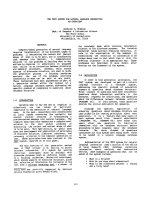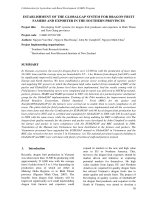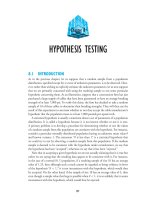Ebook The Bethesda system for reporting cervical cytology (3rd edition): Part 1
Bạn đang xem bản rút gọn của tài liệu. Xem và tải ngay bản đầy đủ của tài liệu tại đây (8.71 MB, 158 trang )
The Bethesda System
for Reporting
Cervical Cytology
Definitions, Criteria,
and Explanatory Notes
Third Edition
Ritu Nayar
David C. Wilbur
Editors
123
The Bethesda System for Reporting
Cervical Cytology
Ritu Nayar • David C. Wilbur
Editors
The Bethesda System
for Reporting Cervical
Cytology
Definitions, Criteria, and Explanatory
Notes
Third Edition
Editors
Ritu Nayar
Deparment of Pathology
Northwestern University
Feinberg School of Medicine
Northwestern Memorial Hospital
Chicago, IL
USA
David C. Wilbur
Department of Pathology
Harvard Medical School
Massachusetts General Hospital
Boston, MA
USA
ISBN 978-3-319-11073-8
ISBN 978-3-319-11074-5
DOI 10.1007/978-3-319-11074-5
(eBook)
Library of Congress Control Number: 2015935366
Springer Cham Heidelberg New York Dordrecht London
© Springer International Publishing Switzerland 2015
This work is subject to copyright. All rights are reserved by the Publisher, whether the whole or part of the
material is concerned, specifically the rights of translation, reprinting, reuse of illustrations, recitation,
broadcasting, reproduction on microfilms or in any other physical way, and transmission or information
storage and retrieval, electronic adaptation, computer software, or by similar or dissimilar methodology
now known or hereafter developed. Exempted from this legal reservation are brief excerpts in connection
with reviews or scholarly analysis or material supplied specifically for the purpose of being entered and
executed on a computer system, for exclusive use by the purchaser of the work. Duplication of this publication or parts thereof is permitted only under the provisions of the Copyright Law of the Publisher’s
location, in its current version, and permission for use must always be obtained from Springer. Permissions
for use may be obtained through RightsLink at the Copyright Clearance Center. Violations are liable to
prosecution under the respective Copyright Law.
The use of general descriptive names, registered names, trademarks, service marks, etc. in this publication does not imply, even in the absence of a specific statement, that such names are exempt from the
relevant protective laws and regulations and therefore free for general use.
While the advice and information in this book are believed to be true and accurate at the date of publication, neither the authors nor the editors nor the publisher can accept any legal responsibility for any errors
or omissions that may be made. The publisher makes no warranty, express or implied, with respect to the
material contained herein.
Printed on acid-free paper
Springer is part of Springer Science+Business Media (www.springer.com)
Foreword
It is a privilege, a pleasure, and something of a surprise for me to write this Foreword
to the third edition of the Cervical Cytology Bethesda System Atlas. I never imagined that a small meeting on the campus of the National Institutes of Health in
Bethesda, Maryland, one snowy weekend in December 1988 would begin a process
that has changed the practice of cervical cytology – in both the laboratory and the
clinician’s office – around the world. This third edition of the atlas continues that
evolution, presenting the latest refinements to the Bethesda System (TBS) in a convenient easy-to-use reference designed to be accessible for cytopathologists and
cytotechnologists regardless of laboratory setting.
The initial Bethesda System workshop was convened to address a well-recognized
but seemingly intractable problem of variability in laboratory reports of Papanicolaou
smears [1]. Different laboratories used a multiplicity of terms including, in many
cases, Pap class numbers, with confusing and idiosyncratic modifications, or dysplasia terminology with multiple, poorly reproducible gradations including a biologically inaccurate distinction between changes induced by human papillomavirus
(HPV) and what was considered “true dysplasia.” Additionally, a non-reproducible
distinction between severe dysplasia and carcinoma in situ was sometimes used
clinically to decide if a hysterectomy should be performed.
The first Bethesda workshop, ably chaired by Dr. Robert Kurman, convened
roughly three dozen laboratorians, clinicians, and research scientists with the goal
of finding a better way. Over 2 days, the following fundamental principles emerged
that have guided the Bethesda System from that day to this:
1. Terminology used by the laboratory must communicate appropriate and clinically relevant information to the clinician
2. Terminology should be consistent from one laboratory to another and reasonably
reproducible in practice but at the same time be flexible enough to be adapted in
a wide variety of laboratories and geographic settings
3. Terminology should be continuously updated to reflect the most current understanding of the pathobiology of cervical neoplasia and integrate advances in
laboratory practice
With these principles in mind, the workshop participants developed terminology based on the underlying pathobiology of the morphologic changes of cervical
v
vi
Foreword
epithelial abnormalities. Squamous intraepithelial lesion (SIL) with only two
gradations (low and high grade) reflected the different biologic states of productive
HPV infections versus lesions with a higher risk of transitioning to precancer and
ultimately cancer. In addition to the SIL terminology, TBS also introduced the
concept of a “statement of adequacy” of the specimen as an integral part of the
report and an important quality assurance element. The new terminology was
named after the location of the workshop in Bethesda, Maryland.
Fast-forward 25 years:
Additional Bethesda System workshops were convened in 1991 and 2001, and
the first two editions of this atlas were published in 1994 and 2004 [2, 3]. Each of
these events was part of the continuing evolution of both scientific knowledge and
clinical practice, in particular:
1. A major recommendation from the 1991 workshop was that criteria should be
developed for the diagnostic terms and for the determination of specimen adequacy, which led to the publication of the first atlas [2].
2. The workshop in 2001 was the first to utilize the Internet in order to provide
everyone an opportunity for input; over 2,000 comments were considered prior
to the meeting, which then brought together over 400 participants including representatives from over two dozen countries [4].
3. Developments in laboratory practice and the transition for many to liquid-based
cytology led to incorporating images and criteria specific to these preparations in
the 2004 atlas [3].
Of all the changes introduced by TBS, none has been as controversial as “atypical
squamous cells of undetermined significance” or ASC-US. ASC-US highlighted the
inherent limitations of morphologic interpretation. Cytologic findings may be equivocal, resulting in frustration for clinicians who need to be able to make clear-cut management decisions. As ASC-US was (and still is) the most common cytologic
abnormality reported for millions of women in the USA annually, this posed a significant clinical problem and threatened to overwhelm the available colposcopy services.
In response, the US National Cancer Institute sponsored a clinical trial, the
ASCUS-LSIL Triage Study, or ALTS, to resolve the question of best practice [5].
The results of ALTS established molecular testing for HPV as the most costeffective approach to clarify equivocal cytologic findings. HPV testing is now firmly
integrated into algorithms both for primary cervical screening and cytology triage.
The results of ALTS and other clinical research have, in turn, informed the
development of clinical management algorithms involving dozens of organizations
and professional societies, spearheaded by the American Society for Colposcopy
and Cervical Pathology, most recently in 2012 [6]. At a time when there were
few test options for screening and evaluation of abnormal findings, management
algorithms consisted of linear branch points based on a sequence of test results.
With the multiplicity of testing options currently available, as well as additional
assays on the horizon, various combinations of cytologic, molecular, and/or histopathologic test findings must now be integrated in order to determine an individual woman’s risk for precancer/cancer and – based on that level of risk – her
Foreword
vii
appropriate management. A new chapter on a risk assessment-based management
has been added to this atlas.
Beyond the field of cervical cytology, standardized terminology systems have
now been developed for cytology of other body sites including thyroid [7] and pancreas [8], and most recently urine [9]. The two-tier terminology used in TBS has
also been recommended for reporting histopathology of HPV-related squamous
lesions of the lower anogenital tract [10, 11].
Terminology must evolve to keep pace with our insights into the basis of disease,
to be responsive to the needs of the laboratory and clinician for clear communication, and ultimately to best serve women’s health. True to the spirit of the underlying principles that guided the first Bethesda workshop, this third edition of the atlas
refines the application of the Bethesda terminology based on experience gathered
over the past decade, especially related to the morphology of liquid-based preparations and use of TBS in clinical practice.
Diane Solomon, M.D.
National Cancer Institute (Retired)
Bethesda, Maryland, USA
References
1. National Cancer Institute Workshop. The 1988 Bethesda system for reporting cervical/vaginal
cytologic diagnoses. JAMA. 1989;262:931–34.
2. Kurman RJ, Solomon D (Eds). The Bethesda system for reporting cervical/vaginal cytologic
diagnoses. Definitions, criteria, and explanatory notes for terminology and specimen adequacy.
NewYork: Springer-Verlag; 1994.
3. Solomon D, Nayar R (Eds). The Bethesda system for reporting cervical cytology. Definitions,
criteria, and explanatory notes. NewYork: Springer-Verlag; 2004.
4. Solomon D, Davey D, Kurman R, Moriarty A, OConnor D, Prey M, et al. The Bethesda system
2001: terminology for reporting the results of cervical cytology. JAMA 2002;287:2114–9.
5. Schiffman M, Adrianza ME. ASCUS-LSIL Triage Study. Design, methods and characteristics
of trial participants. Acta Cytol. 2000;44(5):726–42.
6. Massad LS, Einstein MH, Huh WK, Katki HA, Kinney WK, Schiffman M, et al. 2012 updated
consensus guidelines for the management of abnormal cervical cancer screening tests and
cancer precursors. J Low Genit Tract Dis. 2013;17(5 Suppl 1):S1–27.
7. Ali SZ, Cibas ES (Eds). The Bethesda system for reporting thyroid cytopathology. Definitions,
criteria, and explanatory notes. New York:Springer;2010.
8. Layfield LJ, Pitman MB, DeMay RM, Shidham VB. Pancreaticobiliary tract cytology: journey
toward “Bethesda” style guidelines from the Papanicolaou Society of Cytopathology.
Cytojournal. 2014;11:18.
9. Rosenthal D, Wojcik E. The quest for standardization of urine cytology reporting– the evolution of the Paris system. J Am Soc Cytopathol. 2014;3:II–III.
10. Darragh TM, Colgan TJ, Cox JT, Heller DS, Henry MR, Luff RD, et al. The lower anogenital
squamous terminology standardization project for HPV-associated lesions: background and
consensus recommendations from the College of American Pathologists and the American
Society for Colposcopy and Cervical Pathology. Arch Pathol Lab Med. 2012;136:1266–97.
11. Stoler M, Bergeron C, Colgan TJ, Ferenczy AS, Herrington CS, Kim K-R, et al. Epithelial
tumours, part of tumours of the uterine cervix, chapter 7. In: Kurman RJ, Carcangiu ML,
Herrington CS, Young RH (Eds). WHO classification of tumours of female reproductive
organs. 4th ed. IARC: Lyon; 2014. pp.172–98.
Introduction
In the past decade, since the publication of the second edition of the Bethesda Atlas
in 2004, considerable experience has been gained with the use and impact of the
Bethesda terminology for cervical cytology in clinical practice. This includes additional experience with morphology on liquid-based preparations, further insights
into HPV biology, implementation of HPV vaccination, and updated guidelines for
cervical cancer screening and the management of abnormal cervical cytology and
cancer precursors. Thus 2014 seemed to be the appropriate time for a review and
update of the 2001 Bethesda System terminology and incorporation of revisions and
additional information into this third edition of the Bethesda Atlas for cervical
cytology.
Despite recent concern about the demise of the Papanicolaou test, as it gradually
yields its role as a primary cervical cancer screening test to HPV and other biomarker testing, cervical cytology remains the most successful cancer prevention
program ever devised. Its specificity will remain the cornerstone of future screening
regimens, including those in women who have received HPV vaccination.
Additionally, in many settings, cervical cytology will continue to be the first line
screening test based on resources and local preferences. Hence, updating and further refinement of morphologic criteria for the great variety of entities seen in cervical cytology, both neoplastic and non-neoplastic, is an important function of this
edition. Wide dissemination of this comprehensive and relatively inexpensive atlas
will therefore serve to maximize the overall value of the test in all practice
settings.
Since minimal changes were anticipated to the terminology recommended by the
2001 Bethesda System (TBS), there was no consensus workshop held in association
with the 2014 Bethesda System update. Therefore, Dr. Ritu Nayar, President of the
American Society of Cytopathology (ASC) in 2014, appointed a task force, chaired
by Dr. David Wilbur (ASC President in 2002), which was comprised of a relatively
small group of cytopathologists and clinicians/epidemiologists in order to expeditiously accomplish this task. Following literature review and formulation of the proposed new and expanded content for the atlas, a widely advertised Internet-based
public open comment period was initiated within the international cytopathology
community for a 3.5-month period lasting from March through mid-June of 2014.
A total of 2454 responses were received from individuals in 59 countries spread
over a broad demographic, on proposals from each of the atlas’s 12 chapter-based
ix
x
Introduction
surveys. Excellent feedback was gathered on the proposed updates, which was compiled and reviewed by the chapter-based task force working groups. This process
culminated in refinement of positions and content, which were then incorporated
into the 2014 Bethesda System and this accompanying atlas.
This new edition of the atlas expands on the popular features of the prior editions
[1, 2]. A portion of the text and images from the first and second editions have been
retained for this edition, and credit is attributed to the individuals who participated
in the 1988, 1991 and 2001 Bethesda Workshops and those who contributed to the
resultant 1994 and 2004 Bethesda atlases (see Acknowledgments section). This edition has 12 chapters, 6 of which correspond to the major Bethesda interpretive categories, with the remainder being dedicated to other malignant neoplasms, anal
cytology, reporting of adjunctive testing, computer-assisted screening, educational
notes, and a new chapter on cervical cancer risk assessment. Each chapter consists
of a background discussion, a description of definitions and cytologic criteria, brief
explanatory notes that cover difficult morphologic patterns and mimics of epithelial
lesions (where applicable), sample reports, and selected references. Cytologic criteria are described in general for all specimen types in every chapter, followed by any
significant differences related to specific preparation types. (Note that TBS does not
endorse any particular methodology or manufacturer(s) for specimen collection,
computer-assisted screening, adjunctive HPV or other testing). New to this edition
are increased content on basic disease biology as it pertains to each entity and discussions of the current clinical management guidelines.
Over 1000 images were evaluated for this atlas, including the 186 images from
the second edition. The images went through a multistage review process; first by
the relevant chapter group, and secondly by a cytopathologist/cytotechnologist subgroup of the Bethesda 2014 Task Force. Dr. Daniel Kurtycz is credited with the
management of images collected for this edition of the atlas. The 370 illustrations
in this third edition represent a spectrum of morphologic changes seen on both conventional smears and liquid-based preparations (LBPs); 56% are new images and
44% are from the prior two editions; 40% are conventional preparations and 60%
are from LBPs. For LBP specimen illustrations, the figure legends specify which of
the two commonly used methods is illustrated: ThinPrepTM (Hologic, Marlborough,
MA) or BD SurePath™ (BD Diagnostics, Durham NC). Some images represent
classic examples of an entity whereas others were selected to illustrate interpretive
dilemmas or “borderline” morphologic features that may not be interpreted in the
same way by all cytologists. A greater number and variety of “normal” findings as
well as mimics of classic epithelial abnormalities are included in the third edition in
order to provide a more complete representation of the morphologic variations that
can be appreciated in cervical cytology specimens.
Prior to the publication of the second edition [2], selected images were posted on a
website open to cytopathologists and cytotechnologists worldwide. This process was
designed to evaluate inter-observer variability and to provide an educational tool for
cytologists. Results of the Bethesda Interobserver Reproducibility Study (BIRST)
can be viewed online and have also been published [3, 4]. To build on the information
gathered from our experience with the BIRST project in 2003, we posted 85 of the
Introduction
xi
images from this atlas as “unknowns” on a website open to the cytopathology community. Data from this effort, in which over 850 participants submitted their answers
online prior to the publication of this atlas, provides a realistic gauge of interpretive
reproducibility. Information regarding the results of this exercise is available on the
ASC website at www.cytopathology.org. While knowledge of normal morphology,
its variations and epithelial abnormalities is essential, some degree of interobserver
and interlaboratory variability in interpretation will always remain a reality [4, 5].
In parallel with the development of this third edition, a Bethesda 2014 website
resource has also been developed by an ASC Bethesda Website Task Force under
the direction of Drs. Daniel Kurtycz and Paul Staats. In addition to displaying all the
illustrations that are used in this atlas, the website will contain many other examples
of presentations and entities that could not be provided in this print version. The
website group will also be exploring new avenues for delivery of the content which
has been assembled during this update process. For further information on the
Bethesda web atlas please go to the educational resources page on the American
Society of Cytopathology website [6].
Although the Bethesda System was developed primarily for cervical cytology,
specimens from other sites in the lower anogenital tract, such as the vagina and
anus, may be reported using similar terminology. As in the 2001 Bethesda System,
the terms “interpretation” or “result” are recommended instead of “diagnosis” in the
heading of the cervical cytology report. This terminology is preferred because cervical cytology should be viewed primarily as a “screening test, which in some
instances may serve as a medical consultation by providing an interpretation that
contributes to a diagnosis.” A patient’s final diagnosis and management plan integrate not only the cervical cytology result but also the history, clinical findings, and
other laboratory results such as molecular/biomarker testing and biopsy interpretations [2].
As in prior editions, the current editors and authors have committed to making
the third edition affordable, and hence, widely accessible to all including practitioners in low resource environments. No honoraria or royalties will be accepted by the
editors/authors for this work. The editors, the 2014 Bethesda System Task Force
members, and all the dedicated cytologists who have contributed to this wonderful
project over the past quarter of a century are delighted to come together to thank
Drs. Diane Solomon and Robert Kurman for their pioneering vision in initiating the
organization and implementation of the Bethesda System in 1988 [7, 8]. Indeed
Bethesda’s contributions and impact on the field of cervical cancer go far beyond
just standardized reporting terminology. The Bethesda System formed the bedrock
for the furthering of our understanding of HPV biology and provided the framework
necessary for the development of systematic and evidence-based cervical cancer
screening and management guidelines [8]. And finally, Bethesda brought the world
together with one cytologic voice – now able to effectively communicate scientific
and clinical data where previously such was difficult, if not impossible. Because of
Bethesda, the interpretation of a high grade squamous intraepithelial lesion in the
United States is based on exactly the same criteria as in India or anywhere else. On
behalf of the American Society of Cytopathology, we, as a group are pleased to be
xii
Introduction
a part of this ongoing process and hope that the 2014 Bethesda System update and
this corresponding expanded atlas will prove useful in your practice.
Chicago, IL, USA
Boston, MA, USA
Ritu Nayar, M.D.
David C. Wilbur, M.D.
References
1. Kurman RJ, Solomon D (Eds.). The Bethesda system for reporting cervical/vaginal cytologic
diagnoses. Definitions, criteria, and explanatory notes for terminology and specimen adequacy.
New York: Springer-Verlag; 1994.
2. Solomon D, Nayar R (Eds.). The Bethesda system for reporting cervical cytology. Definitions,
criteria, and explanatory notes. New York: Springer; 2004.
3. Bethesda web atlas @ Accessed 6 Oct 2014.
4. Sherman ME, Dasgupta A, Schiffman M, Nayar R, Solomon D. The Bethesda Interobserver
Reproducibility Study (BIRST): a web-based assessment of the Bethesda 2001 System for classifying cervical cytology. Cancer Cytopathol. 2007;111:15–25.
5. Stoler MH, Schiffman M. Interobserver variability of cervical cytologic and histologic interpretations: realistic estimates from the ASCUS-LSIL triage study. JAMA. 2001;285:1500–5.
6. Accessed 20 Jan 2015.
7. National Cancer Institute Workshop. The 1988 Bethesda system for reporting cervical/vaginal
cytologic diagnoses. JAMA. 1989;262:931–4.
8. Solomon D. Foreword. In: Nayar R, Wilbur DC (Eds.). The Bethesda system for reporting
cervical cytology. Definitions, criteria, and explanatory notes. Springer; 2015.
The 2014 BETHESDA SYSTEM FOR REPORTING
CERVICAL CYTOLOGY
SPECIMEN TYPE:
Indicate conventional smear (Pap smear) vs. liquid-based preparation vs. other
SPECIMEN ADEQUACY
• Satisfactory for evaluation (describe presence or absence of endocervical/transformation zone component and any other quality indicators, e.g., partially
obscuring blood, inflammation, etc.)
• Unsatisfactory for evaluation . . . (specify reason)
– Specimen rejected/not processed (specify reason)
– Specimen processed and examined, but unsatisfactory for evaluation of epithelial abnormality because of (specify reason)
GENERAL CATEGORIZATION (optional)
• Negative for Intraepithelial Lesion or Malignancy
• Other: See Interpretation/Result (e.g., endometrial cells in a woman ≥45 years of
age)
• Epithelial Cell Abnormality: See Interpretation/Result (specify ‘squamous’ or
‘glandular’ as appropriate)
INTERPRETATION/RESULT
NEGATIVE FOR INTRAEPITHELIAL LESION OR MALIGNANCY
(When there is no cellular evidence of neoplasia, state this in the General
Categorization above and/or in the Interpretation/Result section of the report-whether or not there are organisms or other non-neoplastic findings)
NON-NEOPLASTIC FINDINGS (optional to report optional to report; list not
inclusive)
• Non-neoplastic cellular variations
– Squamous metaplasia
– Keratotic changes
– Tubal metaplasia
– Atrophy
– Pregnancy-associated changes
xiii
xiv
The 2014 BETHESDA SYSTEM FOR REPORTING CERVICAL CYTOLOGY
• Reactive cellular changes associated with:
– Inflammation (includes typical repair)
• Lymphocytic (follicular) cervicitis
– Radiation
– Intrauterine contraceptive device (IUD)
• Glandular cells status post hysterectomy
ORGANISMS
• Trichomonas vaginalis
• Fungal organisms morphologically consistent with Candida spp.
• Shift in flora suggestive of bacterial vaginosis
• Bacteria morphologically consistent with Actinomyces spp.
• Cellular changes consistent with herpes simplex virus
• Cellular changes consistent with cytomegalovirus
OTHER
• Endometrial cells (in a woman ≥45 years of age)
(Specify if “negative for squamous intraepithelial lesion”)
EPITHELIAL CELL ABNORMALITIES
SQUAMOUS CELL
• Atypical squamous cells
– of undetermined significance (ASC-US)
– cannot exclude HSIL (ASC-H)
• Low-grade squamous intraepithelial lesion (LSIL)
(encompassing: HPV/mild dysplasia/CIN 1)
• High-grade squamous intraepithelial lesion (HSIL)
(encompassing: moderate and severe dysplasia, CIS; CIN 2 and CIN 3)
– with features suspicious for invasion (if invasion is suspected)
• Squamous cell carcinoma
GLANDULAR CELL
• Atypical
– endocervical cells (NOS or specify in comments)
– endometrial cells (NOS or specify in comments)
– glandular cells (NOS or specify in comments)
• Atypical
– endocervical cells, favor neoplastic
– glandular cells, favor neoplastic
The 2014 BETHESDA SYSTEM FOR REPORTING CERVICAL CYTOLOGY
xv
• Endocervical adenocarcinoma in situ
• Adenocarcinoma
– endocervical
– endometrial
– extrauterine
– not otherwise specified (NOS)
OTHER MALIGNANT NEOPLASMS: (specify)
ADJUNCTIVE TESTING
Provide a brief description of the test method(s) and report the result so that it is
easily understood by the clinician.
COMPUTER-ASSISTED INTERPRETATION OF CERVICAL CYTOLOGY
If case examined by an automated device, specify device and result.
EDUCATIONAL NOTES AND COMMENTS APPENDED TO CYTOLOGY
REPORTS (optional)
Suggestions should be concise and consistent with clinical follow-up guidelines
published by professional organizations (references to relevant publications may be
included).
Acknowledgements
Bethesda System Committee Members and Contributors to Bethesda Atlas,
First edition
(Kurman RJ, Solomon D (Eds). The Bethesda System for Reporting Cervical/
Vaginal Cytologic Diagnoses. Definitions, Criteria, and Explanatory Notes for terminology and Specimen Adequacy. New York: Springer-Verlag, 1994).
Robert J. Kurman, M.D. (Chairman, Criteria Committee)
Ronald D. Luff, M.D, M.P.H. (Chairman, Editorial Committee)
Barbara F. Atkinson, M.D., Jonathan S. Berek, M.D., Marluce Bibbo, M.D., Sc.D.,
Thomas A. Bonfiglio, M.D., Christopher P. Crum, M.D., Yener S. Erozan, M.D.,
Yao Shi Fu, M.D., Shirley E. Greening, M.S, J.D., Michael R. Henry, M.D., Donald
E. Henson, M.D., Mujtaba Husain, M.D., Robert V.P. Hutter, M.D., Stanley L.
Inhorn, M.D., Howard W. Jones III, M.D., Nancy B. Kiviat, M.D., Tilde S. Kline,
M.D., Paul A. Krieger, M.D., George D. Malkasian, Jr. M.D., Alexander Meisels,
M.D., Mary L. Nielsen, M.D., Stanley F. Patten, Jr, M.D., Ph.D., Vincent P. Perna,
M.D., Dorothy L. Rosenthal, M.D., Patricia E. Saigo, M.D., Alexander Sedlis, M.D,
Mark E. Sherman, M.D., Diane Solomon, M.D., Theresa Somrak, CT(ASCP), J.D.,
Leo B. Twiggs, M.D, George L. Wied, M.D.
The 2001 Bethesda System Forum Groups and Bethesda Atlas, Second edition
(Solomon D, Nayar R. (Eds) The Bethesda System for Reporting Cervical
Cytology. Definitions, Criteria, and Explanatory Notes. New York: Springer,
2004).
Adequacy:
Authors: George G. Birdsong, Diane D. Davey, Teresa M. Darragh, Paul Elgert, and
Michael R. Henry.
Forum Group Moderators: Diane D. Davey, M.D., George G. Birdsong, M.D.,
Henry W. Buck, M.D., Teresa M. Darragh, M.D., Paul A. Elgert, CT(ASCP), and
Michael R. Henry, M.D., Heather Mitchell, M.D., and Suzanne Selvaggi, M.D.
xvii
xviii
Acknowledgements
Non-Neoplastic Findings
Authors: Nancy A. Young, Marluce Bibbo, Sally-Beth Buckner, Terrance J. Colgan,
and Marianne U. Prey.
Forum Group Moderators: Nancy A. Young, M.D., Marluce Bibbo M.D., SallyBeth Buckner CT(ASCP), Terrance J. Colgan, M.D., Dorothy Rosenthal, M.D.,
and Edward Wilkinson, M.D.
Endometrial Cells
Authors: Ann T. Moriarty and Edmund S. Cibas.
Forum Group Moderators: Edmund S. Cibas, M.D., Gary W. Gill, CT(ASCP),
Meg McLachlin, M.D., Ann T. Moriarty, M.D., Ellen Sheets, M.D., Teresa M.
Somrak, J.D. CT(ASCP), Rosemary E. Zuna, M.D.
Atypical Squamous Cells
Authors: Mark E. Sherman, Fadi W. Abdul-Karim, Jonathan S. Berek, Celeste N.
Powers, Mary K. Sidawy, and Sana O. Tabbara.
Forum Group Moderators: Mark E. Sherman, M.D., Fadi W. Abdul-Karim, M.D.,
Jonathan S. Berek, M.D., Patricia Braly, M.D., Robert Gay, CT(ASCP), Celeste
N. Powers, M.D., Ph.D., Mary K. Sidawy, M.D., and Sana O. Tabbara, M.D.
Epithelial Cell Abnormalities: Squamous
Authors: Thomas C. Wright, Rose Marie Gatscha, Ronald D. Luff, and Marianne U.
Prey.
Forum Group Moderators: Thomas C. Wright, M.D., Richard M. DeMay, M.D.,
Rose Marie Gatscha, CT (ASCP), Lydia Howell, M.D., M.P.H., Ronald D. Luff,
M.D., M.P.H., Volker Schneider, M.D., and Leo Twiggs, M.D.
Epithelial Cell Abnormalities: Glandular
Authors: Jamie L. Covell, David C. Wilbur, Barbara Guidos, Kenneth R. Lee, David
C. Chhieng, and Dina R. Mody.
Forum Group Moderators: David C. Wilbur, M.D., David C. Chhieng, M.D.,
J. Thomas Cox, M.D., Jamie Covell, B.S., CT(ASCP), Barbara Guidos, SCT
(ASCP), Kenneth R. Lee, M.D., and Dina R. Mody, M.D.
Other Malignant Neoplasms
Authors: Sana O. Tabbara and Jamie L. Covell.
Anal-Rectal Cytology
Authors: Teresa M. Darragh, George G. Birdsong, Ronald D. Luff, and Diane D.
Davey.
Forum Group Moderators: Diane D. Davey, M.D., George G. Birdsong, M.D.,
Henry Buck, M.D., Teresa M. Darragh, M.D., Paul A. Elgert, CT(ASCP),
Michael R. Henry, M.D., Heather Mitchell, M.D., and Suzanne Selvaggi, M.D.
Acknowledgements
xix
Ancillary Testing
Authors: Stephen S. Raab and Mark E. Sherman.
Forum Group Moderators: Stephen S. Raab, M.D., Karen A. Allen, SCT(ASCP),
Christine Bergeron, M.D., PhD., Diane Harper, M.D., Walter Kinney, M.D.,
Alexander Meisels, M.D., and Mark E. Sherman, M.D.
Computer -Assisted Interpretation of Cervical Cytology
Authors: Marianne U. Prey.
Forum Group Moderators: Marianne U. Prey, M.D., Michael Facik, CT(ASCP),
Albrecht Reith, M.D., Max Robinowitz, M.D., Mary Rubin, NP, PhD, and Sue
Zaleski, SCT (ASCP).
Educational Notes and Suggestions Appended to Cytology Reports
Authors: Dennis M. O’Connor.
Forum Group Moderators: Dennis M. O’Connor, M.D., Marshall Austin, M.D.,
Ph.D., Lisa Flowers, M.D., Blair Holladay, Ph.D., CT(ASCP), Dennis McCoy,
J.D., Paul Kreiger, M.D., Gabriele Medley, M.D., Jack Nash, M.D., and
Mark Sidoti, J.D.
The 2014 Bethesda System and Bethesda Atlas, Third edition
(Nayar R, Wilbur DC (Eds). The Bethesda System for Reporting Cervical Cytology.
Definitions, Criteria, and Explanatory Notes. Springer, 2015)
The 2014 Bethesda System Task Force
Chairs: Ritu Nayar, M.D. and David C. Wilbur, M.D.
Advisor: Diane Solomon, M.D.
Members: Fadi W. Abdul-Karim, M.D., George G. Birdsong, M.D., David
Chelmow, M.D., David C. Chhieng, M.D., Edmund S. Cibas, M.D.,Teresa M.
Darragh, M.D., Diane D. Davey, M.D., Michael R. Henry, M.D., Walid E.
Khalbuss, M.D., Ph.D., Daniel F.I. Kurtycz, M.D., Dina R. Mody, M.D., Ann T.
Moriarty, M.D., Joel M. Palefsky, M.D., Celeste N. Powers, M.D., Ph.D., Donna
K. Russell, M.Ed., CT(ASCP), HT(ASCP), Mark Schiffman, M.D., M.P.H., Mary
K. Sidawy, M.D., Paul N. Staats, M.D., Mark H. Stoler, M.D., Sana O. Tabbara,
M.D., Alan G.Waxman, M.D., Nicolas Wentzensen, M.D., Ph.D.
Contents
1
Specimen Adequacy . . . . . . . . . . . . . . . . . . . . . . . . . . . . . . . . . . . . . . . . . . 1
George G. Birdsong and Diane Davis Davey
2
Non-Neoplastic Findings . . . . . . . . . . . . . . . . . . . . . . . . . . . . . . . . . . . . . 29
Daniel F.I. Kurtycz, Paul N. Staats, Nancy A. Young, Marluce Bibbo,
Terrence J. Colgan, Marianne U. Prey, and Ritu Nayar
3
Endometrial Cells: The How and When of Reporting . . . . . . . . . . . . . 91
Edmund S. Cibas, David Chelmow, Alan G. Waxman,
and Ann T. Moriarty
4
Atypical Squamous Cells . . . . . . . . . . . . . . . . . . . . . . . . . . . . . . . . . . . . 103
Fadi W. Abdul-Karim, Celeste N. Powers, Jonathan S. Berek,
Mark E. Sherman, Sana O. Tabbara, and Mary K. Sidawy
5
Epithelial Cell Abnormalities: Squamous . . . . . . . . . . . . . . . . . . . . . . 135
Michael R. Henry, Donna K. Russell, Ronald D. Luff,
Marianne U. Prey, Thomas C. Wright Jr, and Ritu Nayar
6
Epithelial Abnormalities: Glandular . . . . . . . . . . . . . . . . . . . . . . . . . . 193
David C. Wilbur, David C. Chhieng, Barbara Guidos,
and Dina R. Mody
7
Other Malignant Neoplasms . . . . . . . . . . . . . . . . . . . . . . . . . . . . . . . . . 241
Sana O. Tabbara and Walid E. Khalbuss
8
Anal Cytology . . . . . . . . . . . . . . . . . . . . . . . . . . . . . . . . . . . . . . . . . . . . . 263
Teresa M. Darragh and Joel M. Palefsky
9
Adjunctive Testing . . . . . . . . . . . . . . . . . . . . . . . . . . . . . . . . . . . . . . . . . 287
Mark H. Stoler, Stephen S. Raab, and David C. Wilbur
10
Computer-Assisted Interpretation of Cervical Cytology . . . . . . . . . . 295
David C. Wilbur, Marianne U. Prey, and Ritu Nayar
xxi
xxii
Contents
11
Educational Notes and Comments Appended
to Cytology Reports . . . . . . . . . . . . . . . . . . . . . . . . . . . . . . . . . . . . . . . . 301
Ritu Nayar, Dennis M. O’Connor, and Teresa M. Darragh
12
Risk Assessment Approach to Management . . . . . . . . . . . . . . . . . . . . 305
Nicolas Wentzensen, Mark Schiffman, David Chelmow,
Teresa M. Darragh, and Alan G. Waxman
Index . . . . . . . . . . . . . . . . . . . . . . . . . . . . . . . . . . . . . . . . . . . . . . . . . . . . . . . . . 315
Abbreviations
ACOG
ACS
AGC
AIN
AIS
ALTS
APK
ASC
ASCCP
ASC-H
ASC-US
ASIL
CAP
CDC
CIN
CMV
cNPV
CP
DARE
DES
ECA
EC/TZ
FDA
FOV
HCG
hpf
HPV
HRA
hrHPV
HSIL
IUD
LAST
LBP
LEEP
American College of Obstetricians and Gynecologists
American Cancer Society
Atypical glandular cells
Anal intraepithelial neoplasia
Adenocarcinoma in situ
ASCUS–LSIL Triage Study
Atypical parakeratosis
Atypical squamous cells
American Society for Colposcopy and Cervical Pathology
Atypical squamous cells cannot exclude an HSIL
Atypical squamous cells of undetermined significance
Anal squamous intraepithelial lesions
College of American Pathologists
Centers for Disease Control
Cervical intraepithelial neoplasia
Cytomegalovirus
Complement of the negative predictive value
Conventional preparation
Digital anorectal exam
Diethylstilbestrol
Epithelial cell abnormality
Endocervical/transformation zone
Food and Drug Administration
Fields of view
Hyperchromatic crowded groups
High–power field
Human papillomavirus
High–resolution anoscopy
High–risk human papillomavirus
High–grade squamous intraepithelial lesions
Intrauterine contraceptive device
Lower Anogenital Squamous Terminology
Liquid–based preparation
Loop electrosurgical excision procedure
xxiii
xxiv
LMP
LSIL
LUS
MMMT
N/C
NILM
NOS
nsc
PNET
PPV
SCC
SCJ
SIL
TBS
UCSF
USPSTF
Abbreviations
Last menstrual period
Low–grade squamous intraepithelial lesion
Lower uterine segment
Malignant Müllerian mixed tumor
Nuclear/cytoplasmic
Negative for intraepithelial lesion or malignancy
Not otherwise specified
Nucleated squamous cells
Ewing/primitive neuroectodermal tumors
Positive predictive value
Squamous cell carcinoma
Squamocolumnar junction
Squamous intraepithelial lesion
The Bethesda system
University of California–San Francisco
United States Preventive Services Task Force









